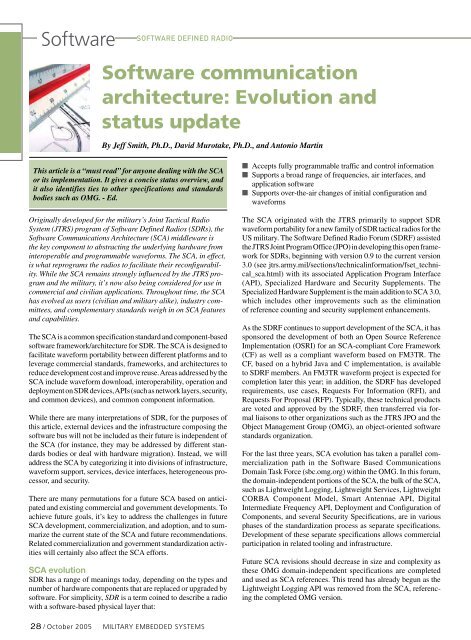Military Embedded Systems - Fall 2005 - Volume 1 Number 2
Military Embedded Systems - Fall 2005 - Volume 1 Number 2
Military Embedded Systems - Fall 2005 - Volume 1 Number 2
You also want an ePaper? Increase the reach of your titles
YUMPU automatically turns print PDFs into web optimized ePapers that Google loves.
Software<br />
Software Defined Radio<br />
Software communication<br />
architecture: Evolution and<br />
status update<br />
By Jeff Smith, Ph.D., David Murotake, Ph.D., and Antonio Martin<br />
This article is a “must read” for anyone dealing with the SCA<br />
or its implementation. It gives a concise status overview, and<br />
it also identifies ties to other specifications and standards<br />
bodies such as OMG. - Ed.<br />
Originally developed for the military’s Joint Tactical Radio<br />
System (JTRS) program of Software Defined Radios (SDRs), the<br />
Software Communications Architecture (SCA) middleware is<br />
the key component to abstracting the underlying hardware from<br />
interoperable and programmable waveforms. The SCA, in effect,<br />
is what reprograms the radios to facilitate their reconfigurability.<br />
While the SCA remains strongly influenced by the JTRS program<br />
and the military, it’s now also being considered for use in<br />
commercial and civilian applications. Throughout time, the SCA<br />
has evolved as users (civilian and military alike), industry committees,<br />
and complementary standards weigh in on SCA features<br />
and capabilities.<br />
The SCA is a common specification standard and component-based<br />
software framework/architecture for SDR. The SCA is designed to<br />
facilitate waveform portability between different platforms and to<br />
leverage commercial standards, frameworks, and architectures to<br />
reduce development cost and improve reuse. Areas addressed by the<br />
SCA include waveform download, interoperability, operation and<br />
deployment on SDR devices, APIs (such as network layers, security,<br />
and common devices), and common component information.<br />
While there are many interpretations of SDR, for the purposes of<br />
this article, external devices and the infrastructure composing the<br />
software bus will not be included as their future is independent of<br />
the SCA (for instance, they may be addressed by different standards<br />
bodies or deal with hardware migration). Instead, we will<br />
address the SCA by categorizing it into divisions of infrastructure,<br />
waveform support, services, device interfaces, heterogeneous processor,<br />
and security.<br />
There are many permutations for a future SCA based on anticipated<br />
and existing commercial and government developments. To<br />
achieve future goals, it’s key to address the challenges in future<br />
SCA development, commercialization, and adoption, and to summarize<br />
the current state of the SCA and future recommendations.<br />
Related commercialization and government standardization activities<br />
will certainly also affect the SCA efforts.<br />
SCA evolution<br />
SDR has a range of meanings today, depending on the types and<br />
number of hardware components that are replaced or upgraded by<br />
software. For simplicity, SDR is a term coined to describe a radio<br />
with a software-based physical layer that:<br />
n<br />
n<br />
n<br />
Accepts fully programmable traffic and control information<br />
Supports a broad range of frequencies, air interfaces, and<br />
application software<br />
Supports over-the-air changes of initial configuration and<br />
waveforms<br />
The SCA originated with the JTRS primarily to support SDR<br />
waveform portability for a new family of SDR tactical radios for the<br />
US military. The Software Defined Radio Forum (SDRF) assisted<br />
the JTRS Joint Program Office (JPO) in developing this open framework<br />
for SDRs, beginning with version 0.9 to the current version<br />
3.0 (see jtrs.army.mil/sections/technicalinformation/fset_technical_sca.html)<br />
with its associated Application Program Interface<br />
(API), Specialized Hardware and Security Supplements. The<br />
Specialized Hardware Supplement is the main addition to SCA 3.0,<br />
which includes other improvements such as the elimination<br />
of reference counting and security supplement enhancements.<br />
As the SDRF continues to support development of the SCA, it has<br />
sponsored the development of both an Open Source Reference<br />
Implementation (OSRI) for an SCA-compliant Core Framework<br />
(CF) as well as a compliant waveform based on FM3TR. The<br />
CF, based on a hybrid Java and C implementation, is available<br />
to SDRF members. An FM3TR waveform project is expected for<br />
completion later this year; in addition, the SDRF has developed<br />
requirements, use cases, Requests For Information (RFI), and<br />
Requests For Proposal (RFP). Typically, these technical products<br />
are voted and approved by the SDRF, then transferred via formal<br />
liaisons to other organizations such as the JTRS JPO and the<br />
Object Management Group (OMG), an object-oriented software<br />
standards organization.<br />
For the last three years, SCA evolution has taken a parallel commercialization<br />
path in the Software Based Communications<br />
Domain Task Force (sbc.omg.org) within the OMG. In this forum,<br />
the domain-independent portions of the SCA, the bulk of the SCA,<br />
such as Lightweight Logging, Lightweight Services, Lightweight<br />
CORBA Component Model, Smart Antennae API, Digital<br />
Intermediate Frequency API, Deployment and Configuration of<br />
Components, and several Security Specifications, are in various<br />
phases of the standardization process as separate specifications.<br />
Development of these separate specifications allows commercial<br />
participation in related tooling and infrastructure.<br />
Future SCA revisions should decrease in size and complexity as<br />
these OMG domain-independent specifications are completed<br />
and used as SCA references. This trend has already begun as the<br />
Lightweight Logging API was removed from the SCA, referencing<br />
the completed OMG version.<br />
28 / October <strong>2005</strong> <strong>Military</strong> EMBEDDED SYSTEMS
















